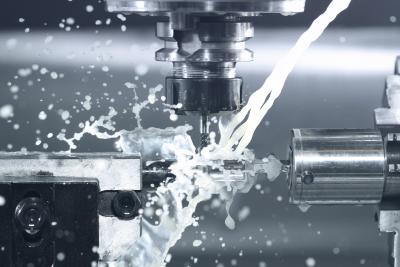
Duracool BR 300 from Enterprise Oil Co. represents an advanced technology in biostable cutting and grinding coolants. Duracool BR 300 is a semisynthetic cutting and grinding fluid with a high oil content for machining all metals from high-alloy stainless steels to aluminum and copper-based alloys.
Duracool BR 300 addresses the problem of multiple coolants in a shop. Duracool BR 300 is unique in that it can be used as a cutting fluid for all machining applications, including severe applications such as aluminum tapping and gundrilling, but can also be used for all water-based grinding applications.
Duracool BR 300 is formulated to be resistant to biological degradation and thus eliminates “Monday morning odors.” Duracool BR 300 has high operator acceptance due to its extremely eco-friendly additive package containing no chlorine, sulfur, nitrites, phenolics, heavy metals or dyes, according to the company.
Duracool BR 300 has the lubricity of a soluble oil and the cleanliness of a synthetic. As a result, Duracool BR 300 maintains exceptional cleanliness of both the interior and exterior of a machine tool. Duracool BR 300 has a heavy-duty corrosion package that prevents rusting on all surfaces of the machine including the toolholders. It also gives exceptional rust protection to machined cast iron parts.
Duracool BR 300 will not foam in high-pressure coolant systems even when exceeding 1,000 psi. Duracool BR 300 is 100 percent recyclable, making it environmentally friendly. Duracool BR 300 rejects tramp oils readily so they can be easily skimmed off either in the machine tool or in an exterior recycling system. There should never be a need to dispose of the coolant reducing disposal costs dramatically.
Contact Details
Related Glossary Terms
- alloys
alloys
Substances having metallic properties and being composed of two or more chemical elements of which at least one is a metal.
- coolant
coolant
Fluid that reduces temperature buildup at the tool/workpiece interface during machining. Normally takes the form of a liquid such as soluble or chemical mixtures (semisynthetic, synthetic) but can be pressurized air or other gas. Because of water’s ability to absorb great quantities of heat, it is widely used as a coolant and vehicle for various cutting compounds, with the water-to-compound ratio varying with the machining task. See cutting fluid; semisynthetic cutting fluid; soluble-oil cutting fluid; synthetic cutting fluid.
- cutting fluid
cutting fluid
Liquid used to improve workpiece machinability, enhance tool life, flush out chips and machining debris, and cool the workpiece and tool. Three basic types are: straight oils; soluble oils, which emulsify in water; and synthetic fluids, which are water-based chemical solutions having no oil. See coolant; semisynthetic cutting fluid; soluble-oil cutting fluid; synthetic cutting fluid.
- grinding
grinding
Machining operation in which material is removed from the workpiece by a powered abrasive wheel, stone, belt, paste, sheet, compound, slurry, etc. Takes various forms: surface grinding (creates flat and/or squared surfaces); cylindrical grinding (for external cylindrical and tapered shapes, fillets, undercuts, etc.); centerless grinding; chamfering; thread and form grinding; tool and cutter grinding; offhand grinding; lapping and polishing (grinding with extremely fine grits to create ultrasmooth surfaces); honing; and disc grinding.
- gundrilling
gundrilling
Drilling process using a self-guiding tool to produce deep, precise holes. High-pressure coolant is fed to the cutting area, usually through the gundrill’s shank.
- lubricity
lubricity
Measure of the relative efficiency with which a cutting fluid or lubricant reduces friction between surfaces.
- stainless steels
stainless steels
Stainless steels possess high strength, heat resistance, excellent workability and erosion resistance. Four general classes have been developed to cover a range of mechanical and physical properties for particular applications. The four classes are: the austenitic types of the chromium-nickel-manganese 200 series and the chromium-nickel 300 series; the martensitic types of the chromium, hardenable 400 series; the chromium, nonhardenable 400-series ferritic types; and the precipitation-hardening type of chromium-nickel alloys with additional elements that are hardenable by solution treating and aging.
- tapping
tapping
Machining operation in which a tap, with teeth on its periphery, cuts internal threads in a predrilled hole having a smaller diameter than the tap diameter. Threads are formed by a combined rotary and axial-relative motion between tap and workpiece. See tap.
